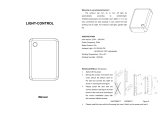Table of Contents
1 Introduction ............................................................................ 5
1.1 General Instructions ................................................................ 5
1.2 Intended Use ........................................................................... 5
1.3 Important Notes ....................................................................... 6
1.4 Connector Pin Assignment ...................................................... 7
2 Safety Notes ........................................................................... 9
2.1 Operating Conditions ............................................................. 11
3 Technical Data ..................................................................... 15
3.1 Control Inputs and Outputs (Version I) .................................. 18
3.2 Control Inputs and Outputs (Version II) ................................. 22
3.3 Signal Diagrams .................................................................... 27
4 Installation ............................................................................ 29
4.1 Set up the Print Module ......................................................... 29
4.2 Connect the Print Module ...................................................... 30
4.3 Switch the Print Module on and off ........................................ 30
4.4 Initial Operation of the Print Module ...................................... 31
5 Load Media ........................................................................... 33
5.1 Load Label Roll in Peel off Mode .......................................... 33
5.2 Load Label Roll in Passing Mode .......................................... 34
5.3 Load Transfer Ribbon ............................................................ 35
6 Keyboard .............................................................................. 37
6.1 Keyboard Assignment (Standard) ......................................... 37
6.2 Keyboard Assignment (Text Entry/Customized/Memory Card)
38
7 Function Menu ..................................................................... 41
7.1 Print Settings ......................................................................... 45
7.2 Label Layout .......................................................................... 46
7.3 Device Settings ...................................................................... 48
7.4 Dispenser I/O ......................................................................... 51
7.5 Interface ................................................................................. 53
7.6 Emulation ............................................................................... 55
7.7 Date & Time ........................................................................... 56
7.8 Service Functions .................................................................. 57
7.9 Main Menu ............................................................................. 60
8 Options ................................................................................. 61
8.1 Ribbon Save .......................................................................... 61
8.2 Network ................................................................................. 61
8.3 Scanner ................................................................................. 62
9 Memory Card ........................................................................ 65
10 Maintenance and cleaning .................................................. 71
10.1 General cleaning ................................................................... 72
10.2 Clean the Transfer Ribbon Drawing Roller ........................... 72
10.3 Clean the Print Roller ............................................................ 73
10.4 Clean the Printhead ............................................................... 74
10.5 Clean the Label Photocell ..................................................... 75
10.6 Replace the Printhead (General) ........................................... 76
10.7 Replace the FlatType Printhead ............................................ 77
10.8 Adjust the FlatType Printhead ............................................... 78
10.9 Replace the CornerType Printhead ....................................... 80
10.10 Adjust the CornerType Printhead .......................................... 81





















